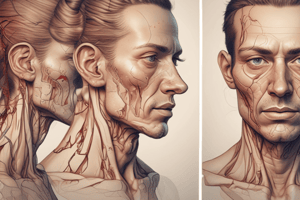Podcast
Questions and Answers
The upper jawbones are called the:
The upper jawbones are called the:
- Mandible
- Maxillae (correct)
- Zygoma
- Mastoid
The lower jawbone is called the:
The lower jawbone is called the:
- Maxillae
- Mandible (correct)
- Mastoid
- Zygoma
The small, rounded, fleshy bulge immediately anterior to the ear canal is called the:
The small, rounded, fleshy bulge immediately anterior to the ear canal is called the:
- Incus
- Stapes
- Pinna
- Tragus (correct)
The superficial temporal artery can be palpated:
The superficial temporal artery can be palpated:
The mastoid process is located approximately:
The mastoid process is located approximately:
The Adam's apple is:
The Adam's apple is:
The cricoid cartilage:
The cricoid cartilage:
What is the function of the sternocleidomastoid muscle?
What is the function of the sternocleidomastoid muscle?
The eyeball itself is referred to as the:
The eyeball itself is referred to as the:
Which of the following statements regarding the vitreous humor is correct?
Which of the following statements regarding the vitreous humor is correct?
The inner surface of the eyelids and the exposed surface of the eye itself are covered by a delicate membrane called the:
The inner surface of the eyelids and the exposed surface of the eye itself are covered by a delicate membrane called the:
The conjunctiva are kept moist by fluid produced by the:
The conjunctiva are kept moist by fluid produced by the:
The white portion of the eye is called the:
The white portion of the eye is called the:
The opening in the center of the iris, which allows light to move to the back of the eye, is called the:
The opening in the center of the iris, which allows light to move to the back of the eye, is called the:
When a light is shone into the pupil:
When a light is shone into the pupil:
Abnormal variations in pupil size and reaction would MOST likely be observed in a patient with:
Abnormal variations in pupil size and reaction would MOST likely be observed in a patient with:
The optic nerve endings are located within the:
The optic nerve endings are located within the:
The MOST significant complication associated with facial injuries is:
The MOST significant complication associated with facial injuries is:
The skin and underlying tissues of the face:
The skin and underlying tissues of the face:
When caring for a patient with an open facial injury, what must the EMT closely assess?
When caring for a patient with an open facial injury, what must the EMT closely assess?
Flashcards are hidden until you start studying
Study Notes
Anatomy of the Face and Neck
- The upper jawbones are called maxillae.
- The lower jawbone is known as the mandible.
- The small bulge in front of the ear canal is called the tragus.
Arteries and Cartilage
- The superficial temporal artery can be palpated just anterior to the tragus.
- The mastoid process is located approximately 1 inch posterior to the external ear opening.
- The Adam's apple is formed by thyroid cartilage, constituting the upper part of the larynx.
- The cricoid cartilage is the only complete circular cartilage in the trachea.
Muscles and Movements
- The sternocleidomastoid muscle allows for head movement.
Anatomy of the Eye
- The eyeball is referred to as the globe.
- The vitreous humor is a jellylike fluid at the back of the eye, unreplaceable if lost.
- Inner eyelids and the eye's surface are covered by the conjunctiva.
- The lacrimal gland produces fluid to keep the conjunctiva moist.
- The white portion of the eye is known as the sclera.
- The center opening of the iris that allows light through is called the pupil.
Pupil Reaction
- When light is shone into the pupil, it becomes smaller in size.
- Abnormal pupil size and reaction variations often indicate a brain injury.
Significance of Facial Injuries
- The most significant complication from facial injuries is airway compromise.
- Facial tissues have a rich blood supply, leading to profuse bleeding when injured.
- During care for open facial injuries, close assessment of the patient’s airway is critical.
Studying That Suits You
Use AI to generate personalized quizzes and flashcards to suit your learning preferences.




